|
|
Review Nokia 3250

Standard kit:
- Nokia 3250 phone
- Nokia Battery BP-6M
- Nokia Connectivity Cable CA-53
- Nokia Compact Charger AC-3*
- Nokia Charger Adapter CA-44*
- Nokia Music Headset HS-20, AD-41
- CD-ROM (
(including Nokia PC Suite software
)
- Manual
- Memory card (Trans Flash 128-512MB), the capacity depends on the market êà
- SD-
adapter for miniSD card
Nokia 3250, live pictures >>

Nokia is replicating similar products built on S60 platform at full speed. After releasing base model, another 3-4 products with small differences between each other in terms of functionality and design appear. Within a certain time interval the models don't have major hardware differences. A lot of things are just software changes, and few additional features, like different camera module, presence or lack of IrDA port. This method is great for saving money on developing new platforms, it's economically correct, but it also leads to problems with explaining differences between the models to the consumer.
Nokia was ignoring the active popularity growth of music phones for some reason. The announcement of Nokia N91 was a strong move, but its sellings should have begun something within 2005, it was really essential. Creating a separate product based on S40 would have automatically turned it into the competitor for Walkman series from Sony Ericsson, and Nokia would actually lose that battle. Nokia decided to act a lot wiser by releasing update for such bestseller as 6630. Let me remind you that this smartphone is a sort of forefather of current generation's products, it has good price/quality ratio (one of the reasons for that is because of the necessity to cycle single-type phones). Special version of Nokia 6630 has Music Edition abbreviation and has 256 Mb memory card, good quality stereo headset in default package and reworked music player. This software came from elder models, Nokia's N70 music player looks exactly the same and has the same features. Nokia simply had to release such product, this is its answer to the ever growing popularity of music phones, a way to satisfy those who simply cannot wait any longer.
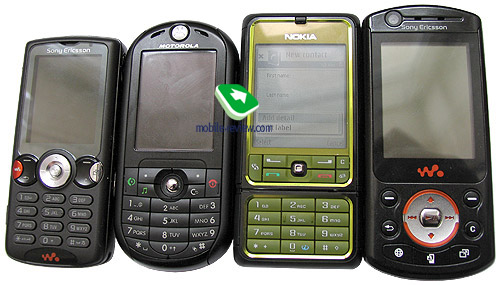
Consumers have skeptic opinion on all kinds of releases of already existing and known phones for quite a long time. The majority thinks that releasing of slightly redesigned version looks like an attempt to sell old product in new wrapping. Motorola's ROKR E1 is a perfect example, there haven't been such huge failure on the market for a long while. Meanwhile the release of Nokia 6630 Music Edition was encountered calmly, there was neither heightened interest nor negative feedback. Unfortunately for Nokia, there weren't many consumers for this model either. The youth prefer phones that have cameras with big resolutions, they choose new models. Consumers are not morally ready to buy an “old” model even with new case color.
A whole different case is when manufacturer places almost the same filling into a different body, speaks about “special” music assignment of the phone and releases it with new index. This game is as old as the world that we are living in, but it's still attractive for the youth. They don't have the “deceived consumer” syndrome (it's a good thing, in case they had it a lot of industries would fall into a deep crisis). Nokia has done a lot of homework, they prepared almost ideal communication with potential focus group of their first smartphone for youth - Nokia 3250. Here it's important to remind you that Nokia has very big experience in releasing such products, unfortunately for them, most of the times it was negative, instead of desired positive, but this forced company to spend more time on planning and doing correction of mistakes. They were the first to release first music phone for youth - Nokia 5510, and its successor - Nokia 3300. These products were met wit enthusiasm, caused battles of supporters and their opponents, but first encounter with reality did not leave these products a chance, they disappeared from retail sale. The company tried their best in order not to repeat their mistakes by taking all of the experience into consideration, with that all put together Nokia 3250 turned out being backed up in all directions.
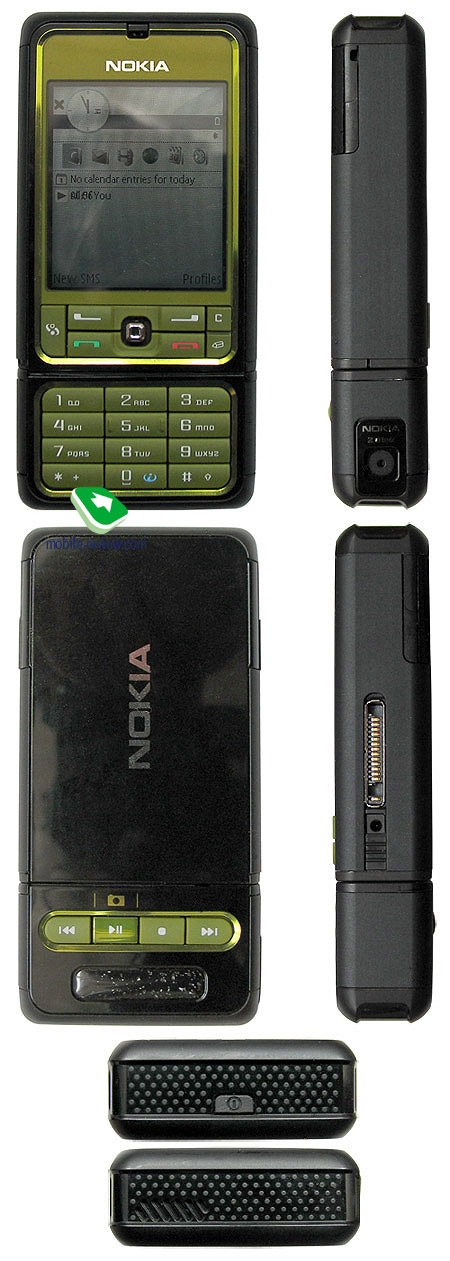
Firstly, the model has to be associated with an expensive phone in terms of form-factor, rotating block's presence. Nokia N90 was taken as an expensive prototype, at the moment it is the only phone with rotating block with camera. Another phone closely related to Nokia 3250 is Nokia N91, a music phone with hard drive. Nokia tries to focus attention of the press and consumers on the fact that 3250 is N91's junior version, music capabilities are similar, although models are placed into two separate classes because of materials used and storage type. Nokia 3250 looks like an inexpensive, cheap analogue of the above mentioned products. But some of the advantages of elder handsets are projected on the junior model. This example of PR program deserves intent attention, this is a highly successful project.
Model's design is unusual, for the first time one of the manufacturer was brave enough to place keypad on the rotating block. The difference between Nokia N90 is huge, since on that model rotating part was used only for camera, and it was not affecting the rest of the phone, it only mattered during photo sessions. The creation of such solution is only a devote to marketing, an attempt to associate Nokia 3250 with an elder model, it was technically possible to place camera module anywhere (in case with N90). On the other side rotating block in some Nokia 3350 will become essential in order to place three megapixel module and prevent phone's size increase. In this model Nokia was testing out the design, what feedback it would receive. It was an attempt to find out weak spots during exploitation by users. Laboratories are of course usable, but collision with reality always results in pleasant and unpleasant surprises.
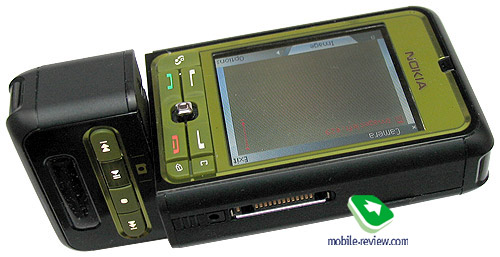
Rotating block is based on one hinge, no doubts, the fastening is safe. The block gets nicely fixed in any of the available positions, just rotate it until you hear the click. The phone cannot “open” by itself when you carry it in your pocket, there's just not enough space to do that. Same can be said about the bags, unless you drop the phone into your sport bag where all stuff is mixed, and you suddenly decided to do some mountain climbing. Casual user will not have any problems with rotating mechanism, the model looks more like a usual phone.
On the other hand buttons placed on two sides of the block (keypad in front and music control buttons on the back) create high probability of accidental key presses. In case you prefer not to use key lock function, you may encounter some problems. There were times when this lead to playback of the last track in the playlist (note that it was in a speakerphone mode). That's why we highly recommend using key lock, you can do it by pressing the turn on/off button and later on selecting the corresponding menu item. The phone lacks automatic key lock feature, but it will be possible to add it with the help of 3 rd party software (currently it is unavailable).
The block can be rotated by 90 and 270 degrees, in these cases camera will start automatically. Small rotation by 90 degrees and the camera will be directed to the usual camera's angle for a mobile phone, the screen acts as viewfinder. Such method is known because of Nikon who was the first manufacturer to use it in their digital cameras. The technology was rather successful. Nokia's 3250 rotating camera mechanism is not perfect, and there are several reasons for that. Firstly, when you rotate it, the camera will not be activated instantly, it will take about 2 seconds before the image will appear on the screen. I'm afraid there's nothing you can do about it, it's a special thing for such models, you will have to wait some time. Secondly, there are no side-keys, which means that you will have to use joystick as the shutter, navigation through the menus is done in the same way. Joystick is only 0.5cm away from the rotating block, people with big hands will find this distance way too small, their finger might slip. The most convenient way for holding the phone is doing it with your right hand, when your thumb will be on the joystick, meanwhile bended forefinger will support the block. In this position your forefinger will not interfere with camera's lens. Other holding positions exist as well, but I did not find them comfortable, usually it was either lens or the screen that got accidental fingertips. It is possible to control the camera with the help of custom music keys
located on the side. In this case you will be holding the main part with one
hand, and with the second you are able to take shots, zoom in/out. In case
you have the chance to use both hands -- this way is convenient, but it's
not in case you don't.
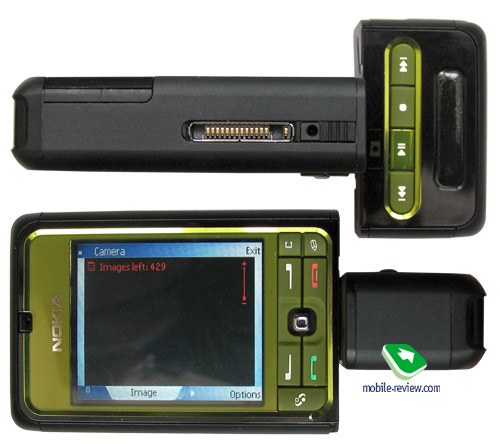
It's easier to setup the camera with your left hand, even though the screen will be covered, but in this case it's not thó probleml. 270 degree rotation is required for taking self-shots (camera will look towards you).
When you rotate the block by 180 degrees mediaplayer will be activated, and now we have music control keys (rewind, stop, pause and playback, 4 of them) instead of keypad in front. Just like with camera, it takes about 2 seconds before the media player will be activated.
Rotating module in action, videoclip (wmv, 9,2 Mb)
No matter in which position the rotating block is located at, you can accept incoming calls, besides, you can also speak normally when you have camera activated, this might look strange, but it works, the person whom you are speaking too will hear you perfectly. As a matter of case, the camera can work without block rotation, some users might find it interesting.
The speaker is located on the lower butt-end, it plays the music and ring tones. There aren't any other speakers in the phone, except for the one used for phone calls. This means that despite speaker's high volume and clear sound of the ring tones you will have to be extra careful when you are carrying the handset in the holster, it's better to use the original one, this way the speaker will not be isolated.
This problem exists only in case if you are using a holster or carring the phone in your pockets, although vibrating alert solves the pocket issue. The sound will not change much when the phone is lying on the table or even turned to vertical position, you will hear it anyway. This is because of the several deepenings inside the case.
Sound, videoclip (wmv, 2 Mb)
The mechanical durability of the rotating block will be a subject to discuss for the first 3-4 months after the phone will be launched for sale, when we will know the breakage statistics. In our case after the phone fell down on the leather couch from 1 meter altitude a small crack near the lens appeared. After some time the block simply opened inside my pocket, the fastening was not reliable enough. According to the company's engineers you will not encounter any problems while using the phone in usual exploitation mode. When the phone is falling out of your hands, well, none of the phones on the market are 100% protected against casualties that might be caused by such accident. Rotating block in Nokia 3250 is its weakest spot. There's no reason to overestimate or underrate this problem, you just have to keep that in mind, it's case's peculiarity.
An iInteresting fact is that the phone's sides are made of metal painted into the phone's main color. This way the main module is protected, meanwhile back side is covered by the battery cover and the battery inside it, the display is covered by some sort of sandwich made of front panel and protective plastic.
Try to guess where the microSD card is located in this handset, considering that hot swapping is supported. Here's the answer: you have to rotate the block, and look at the space that became visible now, you will see the card's icon on the left. Here you can also see screws that seem to be strengthening this part of the case tightly. This impression is deceiving, there's a small hollow on the corner, you can hock the plastic cover, after this operation the slot will open. It's easy to insert and remove the card, but the fact that the card itself is small, and the rotating block is located nearby don't' really put you in the mood for often card change, and we strongly advice you not to do this operation while you are in public transport, or on the street, choose some calm indoor location for such a delicate work.
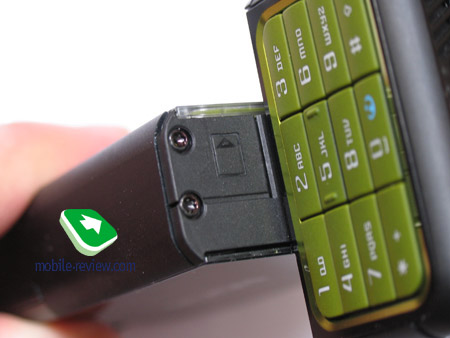
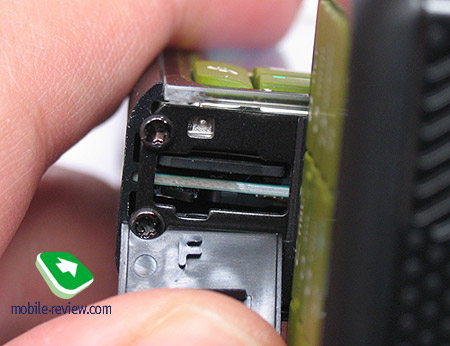
You have to open and close the slot carefully. The front panel does not have an edge, a jerky move can lead to breaking the cover, this happened in our case. The reason for this is the fact that the panel is located on the same level as slot's cover, and it is slightly stepping out when opened. At that place front panel is not covered by anything. It's really easy to break unless you pay special attention to this fact and be accurate.
Back panel is made of thin varnished plastic, it doesn't have any correct fixation, any sort of backlash, it does not squeak when you press on it. Sometimes you might encounter squeaking, but this depends on certain samples, the massive release does not have any problems with the panel. Springy pressure contact, they are fixing the panel. You can remove the panel by pressing the contacts, one at a time. It's hard to get used to dismantling process even after 10-15 times, but in return we have rather reliable fixation.
SIM-card holder (metal locker which leans back to side) is located under the battery, which in its turn is located under the back panel.
Overview, panel, videoclip (wmv, 5,8 Mb)
There aren't any control buttons on the phone's sides, the only button is the above mentioned turn on/off, it is also used for blocking the keyboard during stand by mode and profile switching. The port for charger is located on the right side (thin, which became a standard), there's also an interface connector – Pop Port (located right in the middle). Unlike N91, Nokia 3250 lacks 3.5 headphone jack on the phone itself, such jack exists only in additional headset. When it is connected the phone's width will increase by one centimeter, which is not really comfortable in case you don't have original holster. When I was using this phone I had a strong confidence that a holster, original one, is an essential tool, number one priority. Those who wear sportive shirts with big patch-pockets will not be desperate to get one, but others certainly will. At the moment there's no official holster for Nokia 3250 announced, and the one that can be found for sale, universal for Nokia models, doesn't allow connecting the headset, because the locker is located in that place.
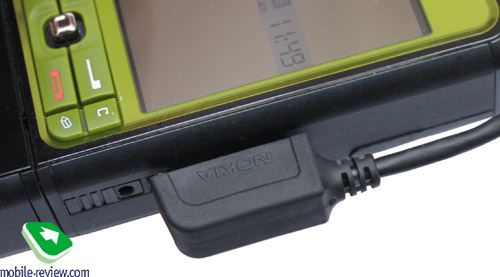
The reason behind placing interface connector in the middle of the case is most likely based on the upcoming release of portable speakers exactly for this model. The new pack of Music Stand for 3250 is not yet announced, but its appearance explains the weird assembling. Plastic stub is present among other parts in default package, it should be used for covering the interface connector, but it's easy to lose it, during first few days of testing we lost ours.
The phone's design can be defined as youth, sort of a rectangular brick in vivid colors, you can also choose a calmer gamma too. Assortment is different only in the color of the keyboard and front panel (it's the same), the rest remains the same. There are four different case colors: black, green, silver and pink. The variety of colors will satisfy even the most demanding consumer. This phone does not support changeable covers.
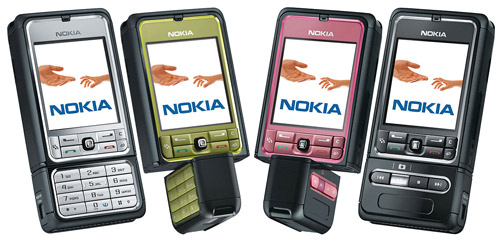
Phone's case gets soiled easily, that's because the surface of front and back panels is glossy, they are made of soft plastic and gather small scratches very quickly. The phone's outlook corresponds to youth models of middle segment, it does not have any advantages over other products, neither by plastic's quality, nor tactile impressions (although metal insertions cause a pleasant cold sensation).
The phone's size is 103.8x50x19.8 mm, the weight, announced by the manufacturer is 115 grams . After measuring it in our laboratory we discovered that its actual weight is 130 grams, without a memory card. The phone's size is typical for smartphones based on S60, take N70 for example, it has similar size. Rectangle shape gives Nokia 3250 impression of additional weight. When you hold the phone in your hand you will get a feeling of a heavy brick.
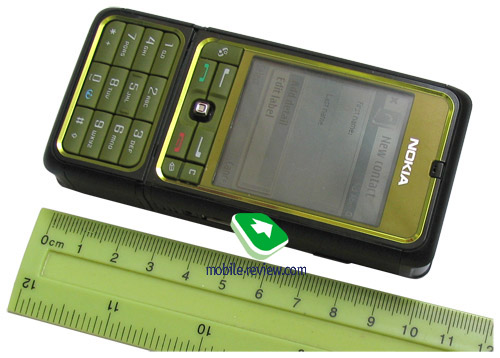
Phone's display resolution is 176x206 pixels (34.8x41.1mm), it can show up to 262000 colors. The phone is identical to the one installed in Nokia N70. But first impression from Nokia 3250's display is rather different. OS update, smaller font size and as a result of this we get some unreadable icons that are supposed to be used on high-definition displays make the phone not so delightful for using as it was with N70. On the other hand, considering the model's segment the display is not so bad after all, it's middle class and here you won't see many smartphones with QVGA-resolution displays.
Nokia 3250 vs Nokia N70, videoclip (wmv, 7,9Mb)
When this model was discussed in our forums, a lot of people mentioned poor screen quality, with the help of engineers from Nokia we managed to find the root of evil. After updating the firmware fonts became normal, some other annoying rudiments were removed too. However even after this operation when compared to N70 display's color profiles seemed to vary.
With maximal brightness level N70 has sharper picture, the colors look more natural, white color has no blue luminance. On the other hand the difference between the screens is not so large, it can be caused by statistical accuracy of matrix from different consignments of, software settings.
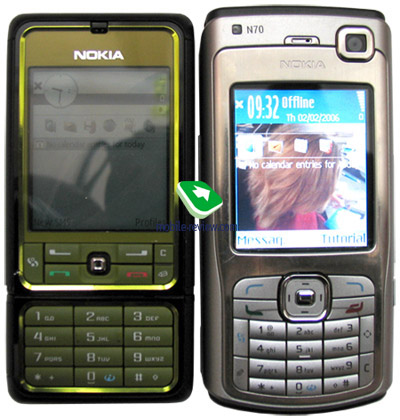
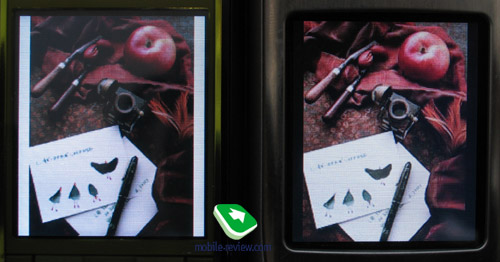
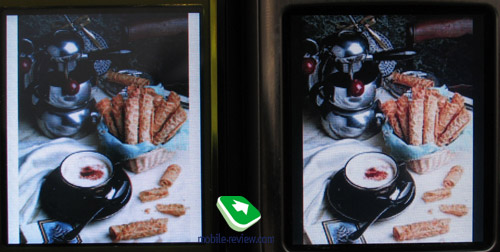
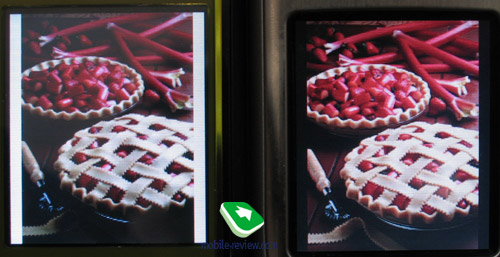
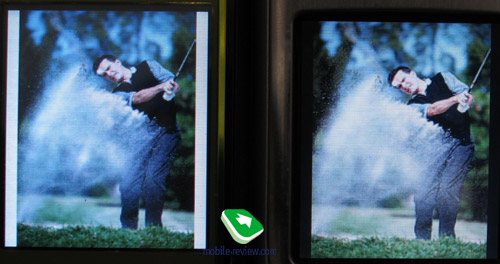
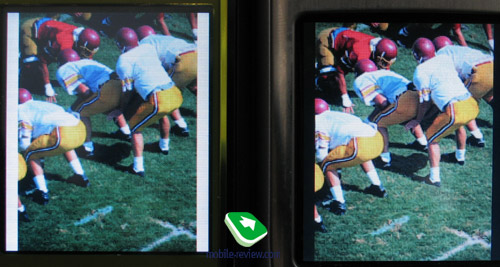
It was interesting to compare the model's display with its potential competitors, Motorola's music phone ROKR E2 can be related to this category too, it also has QVGA-display and different physical size. When ROKR's display is not set to maximum brightness, it looks realistically than 3250's, the picture is sharper, you won't see matrix bars. Although such comparison is not absolutely correct since E2 has one of the best displays on the market, meanwhile Nokia 3250 has qualitative, but average in terms of specifications display.
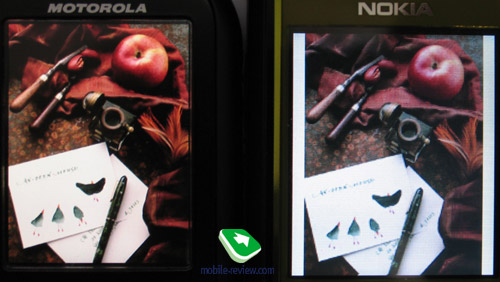
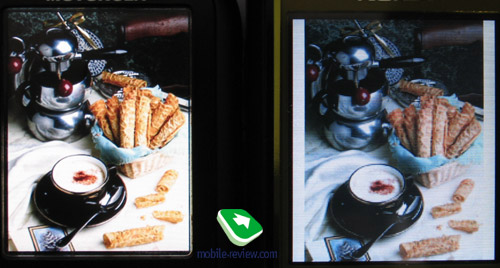
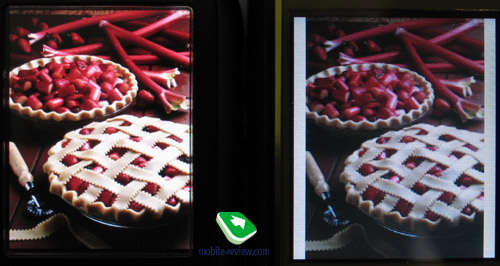
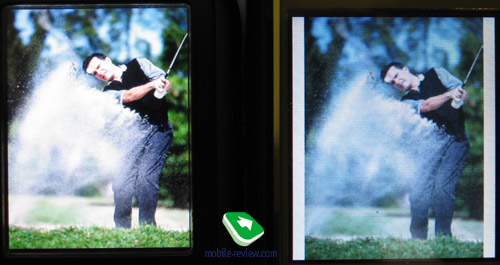
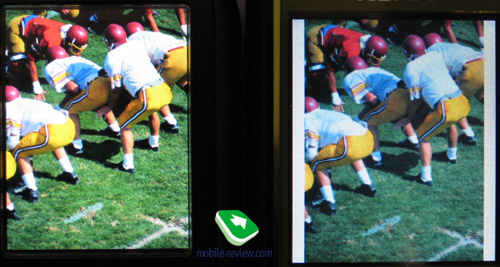
If you compare Sony Ericsson W900 with Nokia 3250, then you will see that W900's picture is softer, but on the whole the images can be compared. You can ' t really say that they are strikingly different .
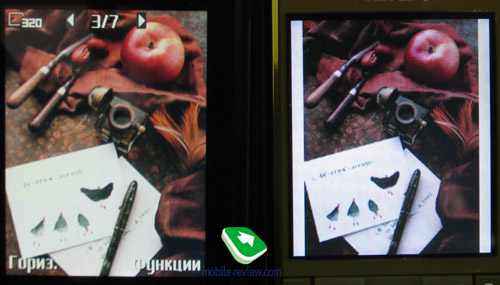
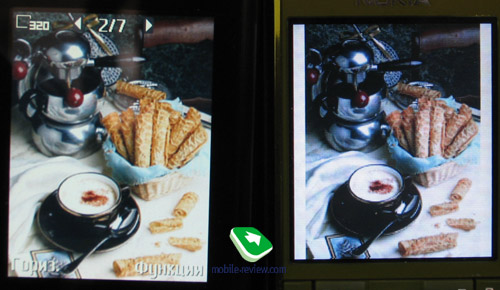
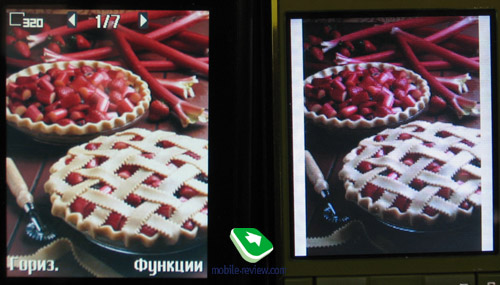
Comparing Nokia 6270 (QVGA resolution) with Nokia 3250 is rather curious. 6270's display quality is higher only because of higher resolution and probably a little bit of bigger brightness.
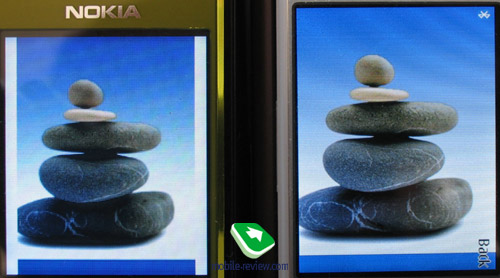
Summing up, Nokia 3250's display is comfortable enough, it would have been extremely unexpected to see better display installed. Display's performance outdoors is okay, although font's size could have been bigger, especially some menu items, when you are outdoors they become simply unreadable.
Interface and display, videoclip (wmv, 2,6Mb)
The keyboard is made of plastic, although if you move your finger around it you might get a feeling that the surface is rubber, it isn't. Our color of the keypad reminded Nokia 5140i's one, perhaps that's where we got the association with keys made of rubber.
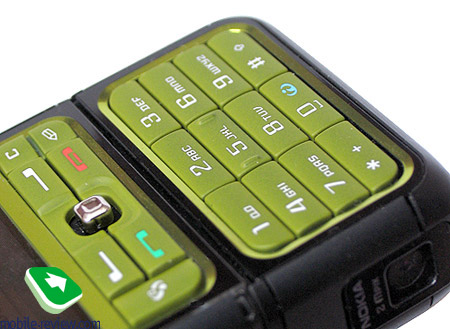
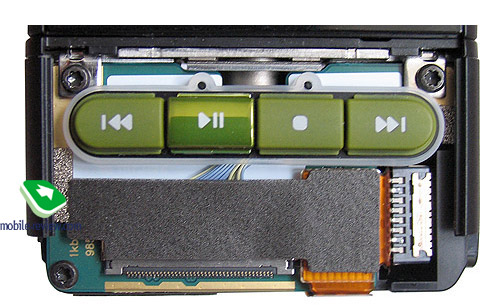
Digital keyas are convenient, the buttons are average in size, and sometimes when you type fast you might get a little backlash of the block. Soft-keys are not so convenient, as well as the C and Symbian's Edit buttons, that's because they are rather small and located on the right. Soft-keys are moved a little bit closer to the center, you have to concentrate in order to press them, and not something else. Most of us are used to press at the button which is located under the sign on the display.
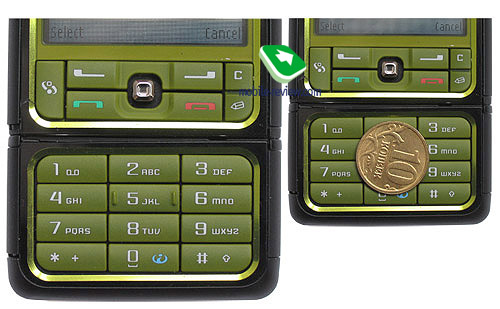
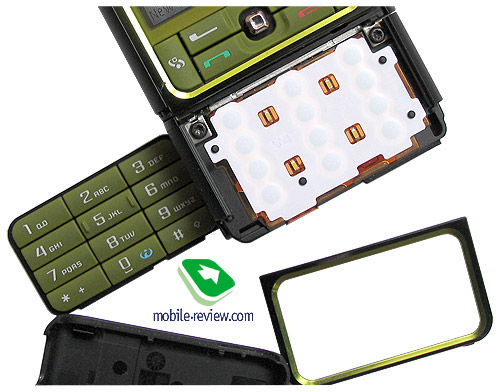
The keypad's backlight color is white, it is clearly seen in various conditions. In case we exclude soft-keys, the ergonomics can be rated at 4 out of 5, but we won't so… We are honestly glad that the experiments with round keyboard are no longer seen, even though they were noticed in previous models of 3xxx series.
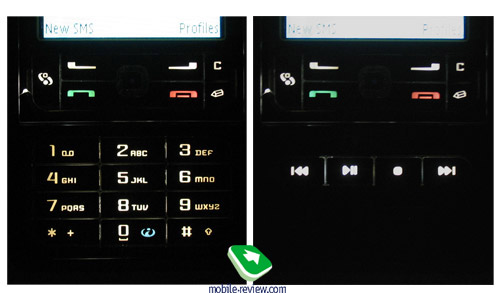
The battery is Li-Polymer, its capacity is 1100 mAh (BP-6M). According to the manufacturer the phone can work up to three hours during your phone calls, and up to 245 hours in the stand by mode, as to the music playback – 10 hours is what Nokia promises. When the network part is disabled, we managed to play one playlist through standard headphones for 11 hours. With network part being enabled this time decreases by 30 minutes. At that time we did not use the phone at all, no phone calls no display activation.
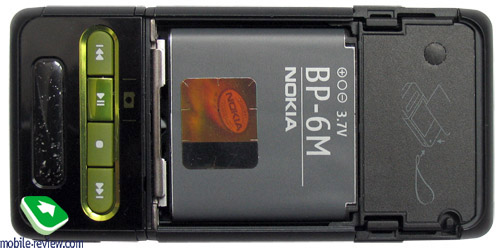
Averagely the phone works for about one day in intensive use mode – one hour spent for phone calls, some messages, up to 20 minutes of web-browsing, use of organizer, alarm clock. In case you don't use it that actively its battery life will increase to two days. Those who listen to music will have to charge the phone daily, this operation takes about 2 hours. Phone's peculiarity is that whenever you talk for more than five minutes, the case becomes warm.
Software peculiarities, camera
Nokia 3250 is built on S60 platform (third edition), this makes the phone related to such models as Nokia N71 and E series. Full description of this platform can be found in the appropriate material, we will not spend time for rewriting what we already wrote.
You should know that because of the OS update this model is not compatible with any application that were available for earlier S60 versions. Only special software that has optimized code for S60 3-rd Edition will work on Nokia 3250. There are certain limitations for Java applications too, although here compatibility is done at a better level.
The phone has only 10 Mb of internal memory, judging by current standards, this capacity is too small. The fact that 128 Mb memory card is included in the package makes the life better, but most users will replace this card with bigger capacity one. There's no big difference for the source where you install software, the access speed is approximately the same. You will have to use PC for uploading big files, but this isn't mobility.
 
 
 
Camera's interface wasn't reworked, like it's done on the latest phones, the reasons behind such action were screen's orientation and peculiarities of joystick's control. Camera's module is 2 megapixel CMOS lens, it's exactly the same as those installed in other smartphones by this company, N70 for example. Because of different image processing algorithm, the photos look sharper on the screen, although the colors are not so bright, color transitions are not so good either. When you look at the photos on your PC you will notice obvious noises, this is typical for all photos, even those done outdoors in perfect lighting conditions. But on the whole outdoor pictures are okay, average. Nokia's 3250 camera is no match for the one installed in Sony Ericsson K750i, SE has more settings, autofocus and macro mode, and final quality of the photos is better. But the camera is not the phone's focus. At a glance photos taken by Nokia 3250 look brighter, have more contrast and
sharper. This is achieved by the rendering algorithm. Concentrate on little
details, you will see that at many shots taken by Nokia 3250 they are
missing. It's easy to achieve same pict
Photo samples taken by Nokia 3250 and Sony Ericsson K750i:
|
|
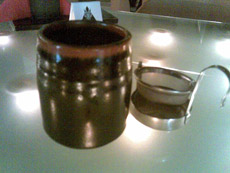 |
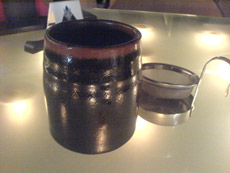 |
(+) increase, 1600x1200, JPEG |
(+) increase, 1632x1224, JPEG |
 |
 |
(+) increase, 1600x1200, JPEG |
(+) increase, 1632x1224, JPEG |
 |
 |
(+) increase, 1600x1200, JPEG |
(+) increase, 1632x1224, JPEG |
 |
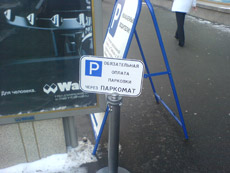 |
(+) increase, 1600x1200, JPEG |
(+) increase, 1632x1224, JPEG |
 |
 |
(+) increase, 1600x1200, JPEG |
(+) increase, 1632x1224, JPEG |
 |
 |
(+) increase, 1600x1200, JPEG |
(+) increase, 1632x1224, JPEG |
 |
 |
(+) increase, 1600x1200, JPEG |
(+) increase, 1632x1224, JPEG |
 |
 |
(+) increase, 1600x1200, JPEG |
(+) increase, 1632x1224, JPEG |
 |
 |
(+) increase, 1600x1200, JPEG |
(+) increase, 1632x1224, JPEG |
 |
 |
(+) increase, 1600x1200, JPEG |
(+) increase, 1632x1224, JPEG |
The following settings for camera can be pointed out:
Screen's resolution – 1600x1200 pixels, 1152x864 and 640x480 pixels. The picture's quality can be one of these three: High, Normal and Baisc. Shooting mode can be either normal, or a series of photos. You can also setup timer (10, 20 or 30 seconds). Night mode is available too. White balance can be setup by three options: Sunny, Incandescent, Fluorescent. Color settings / SFX are standard: Sepia, Black&White, Negative. There's no LED (flash) in this phone. When you are in the shooting mode digital zoom can be activated with joystick. There's no reason to use zoom, since you can scale the photo in the built-in editor, and later on save it, the quality will be higher.
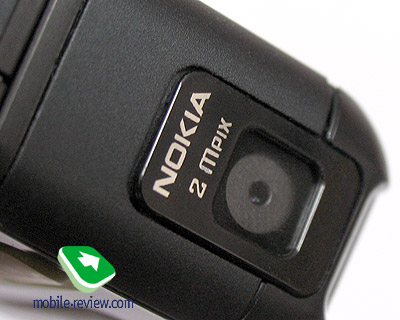
The video recording quality is mediocre, the only available resolutions are 176x144 and 128x96 pixels at 15 frames per second. The recording format is 3GP, you can disable sound if you like. There are no length limitations, unless you setup MMS mode. I'd like to remind you that this camera module is capable of 352x288 pixel video recording, although the quality won't be very good.
Video sample 1 (3gp, 234 Kb)
Video sample 2 (3gp, 56 Kb)
Video sample 3 (3gp, 355 Kb)
By limiting camera ' s possibilities (disabling Scenes and settings) Nokia decided to push the phone into different segment, making it a pure music phone .
Music part of the phone doesn't have any differences from other Nokia smartphones, except for control keys. The phone's musical appropriation is defined by the headphones which is included in the package and special control keys, not the different sound quality or number of settings. The Music Player's appearance is slightly different, it reminds more of products from other manufacturers, than Nokia's very own.
All control elements in the player are placed vertically, you can scroll between them with the help of joystick. 3250 supports progressive rewind, which is a good advantage (here you have to use control keys, since moving joystick to the left and to the right will change the volume, and there are no side-keys). Music Library section allows viewing all music files stored in the phone's internal or external memory. You can sort them by artist name, genre, album and composer. Auto library update is present too, whenever a new file is added – you will instantly see it in the library. Unfortunately I have some bad news for those who wanted to store a big collection of music on his Nokia 3250, there's no Search function, you will have to scroll manually through the corresponding sections.

Separate menu item called Service allows downloading new tracks and demo clips from Nokia's website. It's hard to judge whether this service be in demand or no, but I believe that most users will prefer using their PC for file upload.
The phone supports the following music formats: eAAC+, AAC+, M4A, MPEG-4 ACC LC, LTP, MP3, AMR-NB, AMR-WB, 64 polyphonic MIDI , RealAudio Voice, RealAudio7, RealAudio8, RealAudio10, WMA. The most interesting ones from the big list are: mp3 (all bitrates including variable are supported), AAC in all variations (for iTunes lovers), as well as WMA, which is actively promoted by Microsoft. With the presence of built-in WiFi module just like in Nokia N91 support of RealAudio would have been a real goodie, with all those possibilities like online radios, but since there's no WiFi in Nokia 3250 this format will not be popular among phone owners.
The following modes can be used for any playlist: Shuffle, repeat of 1 track or all of them. There are several equalizer presets, and the chance to create your own ones. The equalizer's influence is slightly noticeable, in order to see it's presence you will have to setup extreme values.
Ability to change channel balance, reverberation effects (there are 8 of them in total: alley, underwater, small, average and big room, big hall) should be considered as additional possibilities. Reverberation is a digital only effect, and its realization is far from perfect. When you use it a certain digital noise, whistling will be noticed in the background of music compositions. Noise level will be either bigger or smaller depending on the type of reverberation. After all the presence of such feature is only a tribute to marketing, there's no practical value in it. Reverberation use in computer games is justifiable, but in portable devices this feature is not so interesting.
 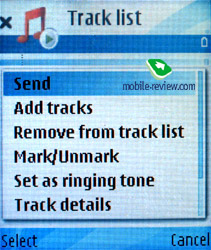
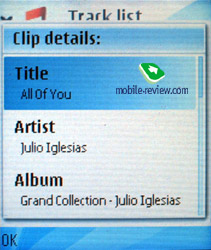 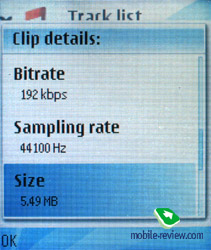
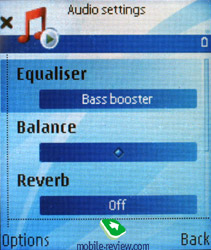 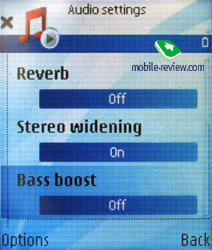
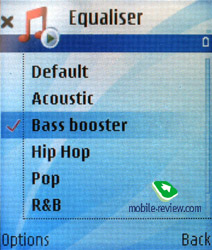
Stereo Widening – stereo base expansion – the simpliest effect which improves sound quality, it is used as the basis for many technologies like SRS WOW. Its realization in Nokia 3250 is doubtful. Built-in tunes get better when this technology is used, that's an obvious fact, the sound becomes drier and flatter. Common users confirmed this fact, even though they were not told when Stereo Widening was in use and when it was disabled. You cannot setup level control. Bass Boost – another feature which cannot be personalized, you can just enable or disable it . The bass is not always worked through correctly . In many songs that are rich in bass it's the low frequencies which get amplified, instead of the bass itself. As a result the sound level becomes equal, there's no amplitude.
The player can be minimized, this way you will see the current playback position and song's title shown on the display. At the moment these two parameters climb one on another, this will be fixed in the upcoming firmware updates.

Speaking about the main display, the font and the location (in the bottom) of song information are not appropriate, it's hard to read. We understand that this is the system font, but since this phone is positioned as a music device, Nokia could have done an exception for 1 application. The funniest thing is that Music Player's interface in Nokia N70 is more pleasant.
The stereo headphones that come as part of the package remind of the ones used in Walkman series (as a matter of fact Sony was the first company to present this headphone type) in terms of appearance, but their quality is yield to Sony's product. Sound quality is very average, there is no workup of high frequencies, bass level is not so good, when you are listening to the music at a high volume you will hear noises in the background, same goes for quiet moments, headphones are the source of this noise. It's highly recommended to change the default headphones, this product of Chinese craftsmen will not be suitable even for average statistical user. Another disadvantage is a headphone's cord, it's too long, and if you add the length of remote control's cord you will end up with enormously large amount of cables. The microphone is located on the remote control, so in case you are using maximum length of the cord it will be problematic for interlocutor to hear what you are saying. Sony Ericsson ' s headsets have shorter cords .
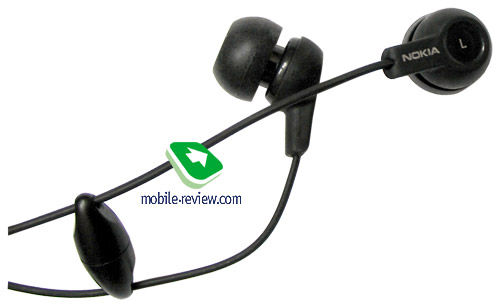
The remote control has few blames, one of them is the plug which has Nokia signs on two sides, but you can only insert the cable into one side. Sometimes it can be misleading, especially when you are trying to plug it in by touch. The remote has Hold button and allows changing the sound volume, rewind function is present too. The playback can be stopped or paused . There's standard 3.5mm jack, which can be used for your personal headphones.
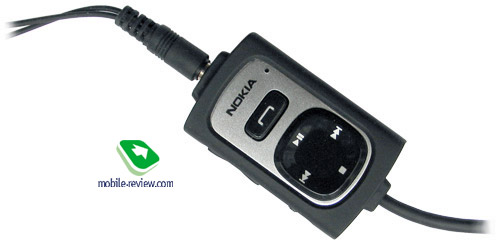
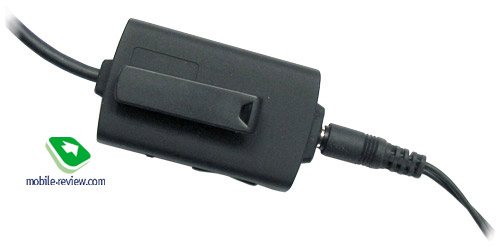
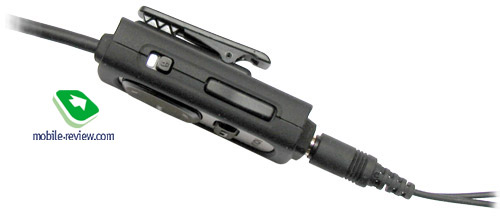
Nokia 3250 is one of the first models in Nokia's line-up to use microSD memory cards. The maximum capacity for this format is 1Gb, according to advertising it's enough for storing up to 750 songs. Well, that's possible in case you use eAAC+ codec and average song length is 3.5 minutes. Most users will not use this codec since the most popular music format is mp3. The real size of your music collection will be smaller. The price of microSD cards is rather big, although they are cheaper than MemorySticks (maximum capacity announced is 8 Gb, you can already buy 2 Gb cards).
The model supports Bluetooth v.2.0 (EDR including), but it does not have A2DP-profile support. This means that you will not be able to use Bluetooth stereo headset. For a smartphone released in 2006 and positioned as a music phone this is a big omission.
The presence of voice dialing which does not depend on the voice of speaker, as well as voice commands that can be activated from the remote control after long hold of Hold button allow controlling the phone without taking it out from the holster or your pocket, it's good. FM-radio is absolutely standard, there's nothing special about it.
Performance. The test results are typical for S60 3 rd edition platform, there aren't any significant changes. Good performance in standard tasks .
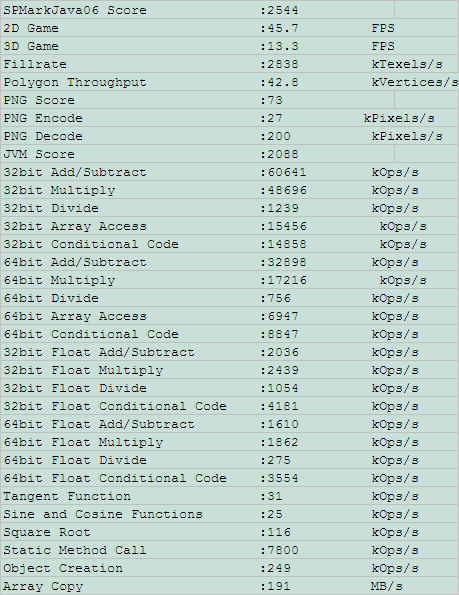
|
3250 |
ROKR E2 |
| JBenchmark 1 |
5666 |
7177 |
Details |
| Text |
1452 |
1835 |
| 2D Shapes |
1356 |
1950 |
| 3D Shapes |
794 |
1036 |
| Fill Rate |
535 |
621 |
| Animation |
1529 |
1735 |
Screen Width
|
176 |
240 |
Screen Height
|
144 |
247 |
Color Screen
|
true |
true |
Number of Colors
|
16777216 |
262144 |
Double Buffer
|
true |
true |
Total Memory
|
614400 |
1048576 |
Free Memory
|
217420 |
439624 |
CLDC - 1.1.1 |
Microedition Profile MIDP-1.0 MIDP-2.0 |
Microedition Platform Nokia3250/3.05 |
ISO-8859-1 |
|
3250 |
ROKR E2 |
| JBenchmark 2 |
519 |
282 |
Details |
| Image manipulation |
352 |
353 |
| Text |
911 |
808 |
| Sprites |
537 |
410 |
| 3d Transform |
801 |
691 |
| User Interface |
271 |
22 |
Screen Width
|
176 |
240 |
Screen Height
|
144 |
247 |
Color Screen
|
true |
true |
Number of Colors
|
16777216 |
262144 |
| JPEG Support |
true |
true |
| Transparency (Alpha Level) |
256 |
4 |
Total Memory
|
614400 |
1048576 |
Free Memory
|
156188 |
586676 |
CLDC - 1.1 |
Microedition Profile MIDP-2.0 |
Microedition Platform: Nokia3250/3.05
|
Microedition Encoding: ISO-8859-1
|
|
3250 |
ROKR E2 |
| JBenchmark 3D HQ |
202 |
2 |
| JBenchmark 3D LQ |
330 |
213 |
| Triangles ps: |
50459 |
24679 |
| kTexes ps: |
2176 |
1973 |
| Screen(canvas)width: |
176 |
240 |
| Screen(canvas)height: |
208 |
320 |
3D Subsystem |
| M3G Version: |
1 |
1 |
| Antialaising: |
false |
false |
| True color: |
false |
false |
| Dithering: |
false |
false |
| Mipmapping: |
true |
false |
| Perspective correction: |
true |
true |
| Local camera lighting: |
false |
false |
| Max lights: |
8 |
256 |
| Max Viewport dimensions: |
1024 |
1024 |
| Max Texture Dimensions: |
256 |
1024 |
| Max Sprite Crop Dimensions: |
256 |
1024 |
| Max Transforms Per Vertex: |
4 |
2 |
| Number of Texture Units: |
2 |
2 |
Other properties: |
| Color Screen |
true |
true |
| Number of colors |
16777216 |
262144 |
| Transparency (alpha level) |
256 |
4 |
| Double buffer |
true |
true |
| Total memory: |
614400
|
1048576 |
| Free memory: |
202616 |
434300 |
MicroEdition Configuration
|
CLDC-1.1 |
CLDC-1.1 |
MicroEdition Profiles:
|
MIDP-2.0 |
MIDP-2.0 |
Microedition Platform:
|
3250/3.05 |
j2me |
Microedition Encoding:
|
ISO-8859-1 |
ISO-8859-1 |
Microedition Locale
|
en |
en |
Microedition Communication ports:
|
COM0, USB0, BT0-BT63
|
USB1 |
| Microedition Hostname: |
localhost
|
null |
3.1.0 |
|
3250 |
ROKR E2 |
Rendering Quality: |
Bilinear filtering:
|
Succes (99%)
|
Failrule (61%) |
Trilinear Filtering:
|
Failrule (80%)
|
Not supported |
Perspective correction:
|
Failrule (85%)
|
Failrule (64%) |
Z-buffer depth:
|
14 bit |
16 bit |
Perfomance: |
Smooth triangles:
|
70524 |
52219 |
Textured triangles:
|
61726 |
8456 |
Fill rate:
|
1300 kTexels
|
850 kTexels |
Gaming:
|
149 (4.1 fps)
|
19 (0.6 fps) |
4.0.3 |
Impressions
The model does not have any problems with network reception quality, the voice of interlocutor is clearly heard, as well as yours. The volume of 64-tone polyphonic ring tone is high in case you use mp3 files. In this case the quality of polyphonic ring tones is not so important. Vibrating alert's power is below average, it cannot be felt all the time.
This model is interesting because it's a smartphone, you can add 3 rd party software if you like. Although at the moment Nokia 3250 will be released the software assortment will stay terribly poor. It will take around 6 months for situation to improve. Incompatibility with old software is a great disadvantage of device targeted for the youth. Young ones like playing games, discovering some interesting 3 rd party software. Worsening of the camera and the amount of settings is understood, one have to sell those more expensive devices with more features from the upper class. Unfortunately the music part of the phone was equaled with the camera's level. When you look at the announced codecs and features on paper – you become impressed, but in reality they are realized poorly, and those who will see that will not add Nokia 3250 to their wish lists. This is exceptionally cheap solution, and the company's aim is not to make it extremely popular. There's no difference in player's abilities comparing to other modern Nokia smartphones except for the remote control (you cannot use it in other models). It's interesting to find out that Nokia N91's sound quality is much better even if you use exterior headphones. What ' s so interesting about it ? The phones are using the same platform .
Comparison of Nokia 3250 with other music phones will follow up, but short summary can be made now, it's clear. Sony Ericsson's solutions have fewer settings in terms of sound customization, but they are more qualitative in the sound playback. Bass in Walkman phones are not nominal, they actually work. Motorola ROKR E2 has bigger set of settings and few exclusive technologies like Spatial Audio, this makes the usage of the phone extremely pleasant. Nokia 3250 is targeted for the youth, who like to flash their phones, but they don't really care about the qualitative comparison of specifications between their phone and other products on the market. The main aim is to impress interlocutor with unimaginable amount of supported codecs, use trendy term "smartphone" and state that this product comes from the leader of the market, and not some Chinese craftsman.
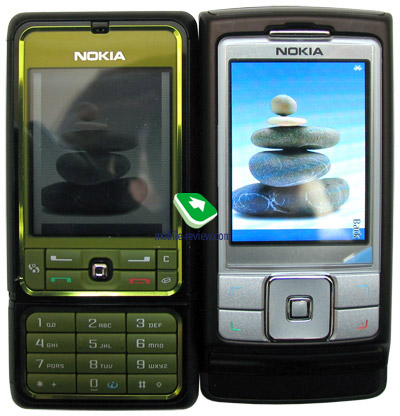
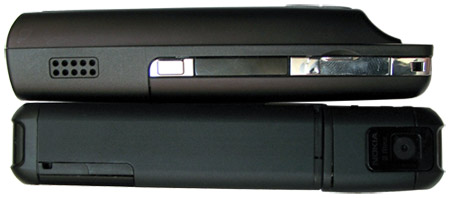
The model is highly overrated by the potential buyers, it is not worth its price. When it will be released, that's April, its price will range from 350 to 360 Euros (in Russia the price will start from $470 and go up). This is appropriate price of S60 3 rd edition smartphone with adjusted functionality, but overstating for the music phone. For example Sony Ericsson W800i is cheaper, has better package and the most important fact – it's great at playing the music, its main destination. This lets us to summarize the following: Nokia 3250 will not become the bestseller on the market, this is a rather niche solution, which might sell well because of good PR campaign and marketing efforts. It's sad that despite having the potential of S60 manufacturers could have created a really impressive product which would become a bestseller, but they did not. On the other hand such task did not exist in the very beginning, the aim was different: creating of narrow assortment model for “cheap” consumers, it was not supposed to be massive.
Eldar Murtazin (eldar@mobile-review.com)
Translated by Alexander "Lexx" Zavoloka (alexander.zavoloka@mobile-review.com)
Published — 12 February 2005
Have something to add?! Write us... eldar@mobile-review.com
|
News:
[ 31-07 16:21 ]Sir Jony Ive: Apple Isn't In It For The Money
[ 31-07 13:34 ]Video: Nokia Designer Interviews
[ 31-07 13:10 ]RIM To Layoff 3,000 More Employees
[ 30-07 20:59 ]Video: iPhone 5 Housing Shown Off
[ 30-07 19:12 ]Android Fortunes Decline In U.S.
[ 25-07 16:18 ]Why Apple Is Suing Samsung?
[ 25-07 15:53 ]A Few Choice Quotes About Apple ... By Samsung
[ 23-07 20:25 ]Russian iOS Hacker Calls It A Day
[ 23-07 17:40 ]Video: It's Still Not Out, But Galaxy Note 10.1 Gets An Ad
[ 19-07 19:10 ]Another Loss For Nokia: $1 Billion Down In Q2
[ 19-07 17:22 ]British Judge Orders Apple To Run Ads Saying Samsung Did Not Copy Them
[ 19-07 16:57 ]iPhone 5 To Feature Nano-SIM Cards
[ 18-07 14:20 ]What The iPad Could Have Looked Like ...
[ 18-07 13:25 ]App Store Hack Is Still Going Strong Despite Apple's Best Efforts
[ 13-07 12:34 ]Infographic: The (Hypothetical) Sale Of RIM
[ 13-07 11:10 ]Video: iPhone Hacker Makes In-App Purchases Free
[ 12-07 19:50 ]iPhone 5 Images Leak Again
[ 12-07 17:51 ]Android Takes 50%+ Of U.S. And Europe
[ 11-07 16:02 ]Apple Involved In 60% Of Patent Suits
[ 11-07 13:14 ]Video: Kindle Fire Gets A Jelly Bean
Subscribe
|









































































